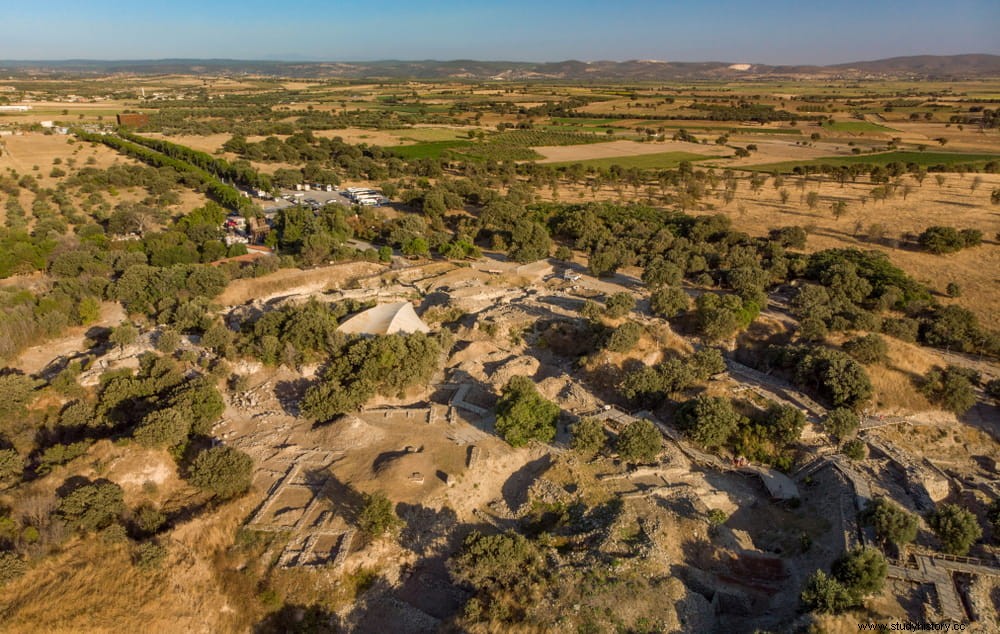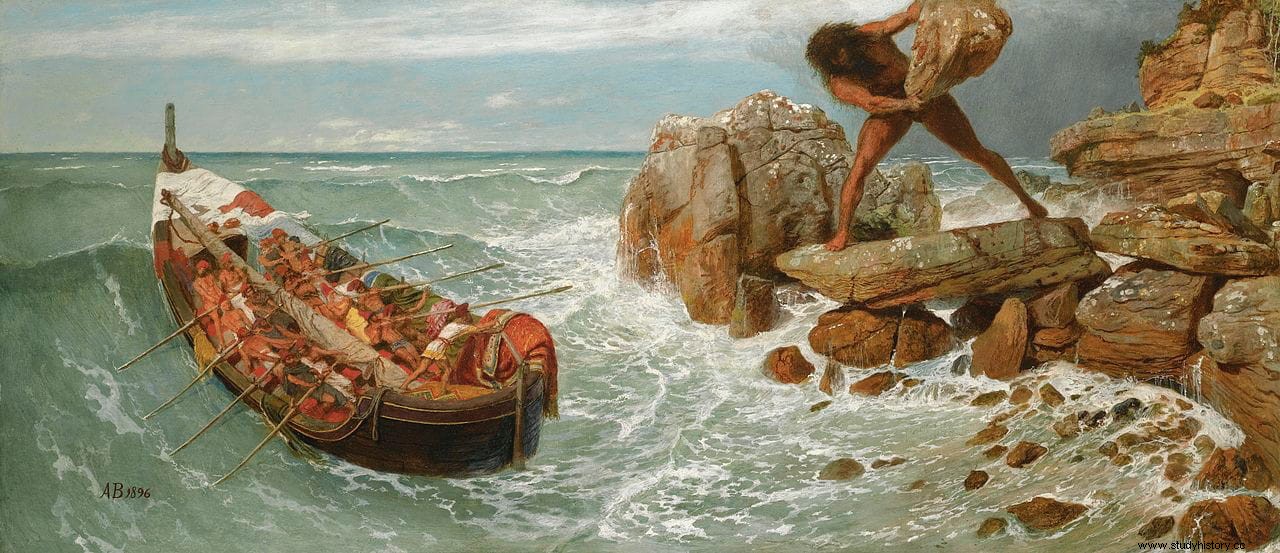The Epic Cycle , also called Trojan Cycle for recounting events related to the Trojan War, they are a collection of eight poems composed in dactylic hexameter, the traditional type of verse in Greco-Latin epics.
The two most famous, because they have been preserved complete, are The Iliad and The Odyssey, both attributed to Homer. Of the remaining six, only fragments have reached us in later works (of some, just a few lines), and a summary of each one in the Chrestomatia (a kind of anthology) of Proclus, (a character about whom little is known other than that he is not the Neoplatonic philosopher who lived in the 5th century AD), so we know his titles and his plot.
All of them have in common their origin in the oral tradition that developed in the Dark Ages of Greece, a period that goes from the disappearance or collapse of the Mycenaean world around 1200-1100 BC. and the archaic period in the 8th century BC, which would be when they began to be written down.

They are attributed to different authors and, in chronological order, are the following:
1. Cipria or Cyprian Songs
The title literally means Cyprus thing , and it is possible that this indicates the origin of its author or its relationship with Aphrodite, a goddess born in Cyprus.
Its authorship is attributed to Stasinus of Cyprus or, according to Photius, to Hegesias. Some ancient authors attribute it to Homer himself, assuring that the Cipria were the wedding present he gave his daughter when he married Estaino. Pindar and other authors mention Stasinus as the author, and even Plato quotes from his work in the Euthyphro in the mouth of Socrates.
Curiously, in 1995 an inscription appeared in Bodrum (ancient Halicarnassus) with a list of Greek poets. Among them was the hitherto unknown Kypria, to whom the inscription attributes the composition of the Iliaka (Jonathan Burgess, Kyprias , 2002).
The poem consisted of 11 books, in which the events that had led to the Trojan War were narrated, as well as the first nine years of it, ending right where The Iliad begins. . Herodotus revealed some contradictions between the two works, such as the fact that the Cipria mention that Paris had come to Troy directly from Sparta, while the Iliad He states that he previously passed through Sidon:

It is not very clear if the Cipria was composed before or after the Iliad . Most experts favor that it was put into writing later. However, many are convinced that the Catalogue of Trojans , which lists in the second book of the Iliad to Trojan warriors and allies, may be taken from the Cypria .
2. Ethiopian
After the Cipria chronologically, the events narrated in the Iliad would go and then the Ethiopid . There were five books attributed to Arctinus of Miletus, a legendary poet who some consider a disciple of Homer, and others like Dionysius of Halicarnassus, the oldest known poet (Ancient History of Rome , I–68.2).
The Ethiopid it was named for Memnon, the Ethiopian king who fought alongside the Trojans after Hector's death, and his account begins right where the Iliad ends. . It begins with the arrival of Penthesilea, the queen of the Amazons (whom Achilles kills in combat), and ends with the death of Achilles and the confrontation between Ajax Telamon and Odysseus for keeping their weapons.
The events narrated in the Etiopida they are among the most popular used by ancient Greek pottery painters.
3. The Little Iliad
After the Ethiopides the four books of the Little Iliad would go , attributed to Lesques de Pirra (city on the island of Lesbos), a poet mentioned by Pausanias and who lived around 700 BC
Here the events are narrated that go from the death of Achilles to the idea of the Greeks to enter Troy through the stratagem of the wooden horse. But the fall and destruction of the city is not counted.
It is also one of the poems of the cycle of which more original lines are preserved:thirty. Aristotle said of it that it had more plots than an epic poem should have .

4. Iliupersis
The two books of the Iliupersis (Sack of Ilium), tell of the destruction of Troy, continuing what is reported in the Little Iliad . The ancients attributed its authorship to Arctinus of Miletus, whom we have already seen as responsible for the Ethiopida .
The narrative begins with the Trojans arguing over what to do with the wooden horse that the Greeks have left where they have camped. And it ends with the sack of the city, the death of King Priam at the hands of Neoptolemus (the son of Achilles) and the murder of Hector's baby, Astyanax, at the hands of Odysseus.
Only ten lines of the original poem have survived. One of the most interesting sources for knowledge of its content is the Aeneid of Virgilio, composed six centuries later, where the facts are told from the Trojan point of view.

In the sanctuary of Delphi the famous painter Polygnotus decorated in the 5th century BC. a wall of the building known as Lesque de los Cnidios with Iliupersis themes . The paintings, which no longer exist, were extensively described by Pausanias:
5. Nostoi
Nostoy , which in Greek means homecomings , were five books where, effectively, the returns of the heroes after the fall of Troy were narrated. Ancient sources attribute it to Agias of Troezen or Eumelus of Corinth, two semi-legendary poets from the 8th century BC.
Diomedes and Nestor manage to get home without major problems. Menelaus is shipwrecked and arrives in Egypt, where he remains for several years. Neoptolemus leaves by land and meets Odysseus on the way. Agamemnon manages to reach Mycenae, where he is killed by her wife Clytemnestra and her lover Aegisthus.
All the Greek heroes manage to reach their home or die on the way, except one, Odysseus. The story of his return is told in the next poem in the cycle:The Odyssey .
6. Telegony
The poem that puts an end to the Epic Cycle is the Telegony , chronologically following the Odyssey . It is attributed to Eugamon of Cyrene, from whom Clement of Alexandria says that he stole the poem Thesprocida to the legendary poet Museo and changed its title.
The reality is that Eugamón must have followed the same oral tradition as other previous poets, who could have written down the same events with different titles. Needless to say, none have been preserved.
The researchers believe that Telegony and Thesprocid they are two names of the same poem, or that the last one could be the first book of the Telegony . In any case, only two lines of the original poem have survived to this day.
It narrates two facts, the journey of Odysseus to Thesprocida and the story of Telegonus. The first begins with the burial of Penelope's suitors and continues with the trip to Thesprocida, where Odysseus performs the sacrifices that Tiresias had entrusted to him in canto 11 of the Odyssey .

The second tells of the arrival in Ithaca of Telegonus, the son of Circe and Odysseus. Without recognizing each other, Telegon fights with Odysseus and mortally wounds him. Once he realizes the mistake he takes his father's body to Eea, Circe's island, where Odysseus is buried. Circe makes Telegonus, Telemachus, and Penelope immortal, and the story ends a bit...strangely:Telegonus marries Penelope, and Telemachus marries Circe.
It is unknown when the eight poems were combined to form the Cycle. Some authors think it occurred as late as the 1st century BC, while others push that date back a little further. Herodotus, for example, already mentions the Cipria in the History of him, written in the 5th century BC
And Aristoxenus, a philosopher who lived in the 4th century BC, knew of an beginning to the Iliad different from the traditional one of Homer, as reflected in the first book of his Praxidamanteia . This alternate beginning was intended to tie together the tale of the Iliad with its immediate predecessor, the Cipria :
